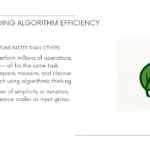Have you ever wondered how your computer can find a specific contact from thousands in your phone in milliseconds? Or how streaming services can sort through millions of movies to show you exactly what you’re looking for? The secret lies in a powerful algorithmic approach called Divide and Conquer.
What is Divide and Conquer?
Divide and Conquer is a fundamental algorithmic paradigm that breaks down complex problems into smaller, more manageable subproblems. Think of it like organizing your messy room – instead of trying to clean everything at once, you tackle one section at a time, making the overall task much more manageable.
The strategy follows three key steps:
- Divide: Break the problem into smaller subproblems
- Conquer: Solve the subproblems recursively
- Combine: Merge the solutions to solve the original problem
Why Use Divide and Conquer?
Before we dive into examples, let’s understand why this approach is so powerful:
- Efficiency: Often reduces time complexity significantly
- Scalability: Works well with large datasets
- Parallelization: Subproblems can often be solved simultaneously
- Simplicity: Complex problems become easier to understand and implement
Real-World Example: Finding a Name in a Phone Book
Imagine you’re looking for “Sarah Johnson” in a physical phone book with 10,000 names. You have two approaches:
Linear Approach: Start from page 1 and flip through every page until you find Sarah. This could take you up to 10,000 checks in the worst case.
Divide and Conquer Approach: Open the book to the middle. If you land on names starting with “M”, you know Sarah comes after this point. Throw away the first half and repeat the process with the remaining half. Continue dividing until you find Sarah.
This second approach is essentially what we call Binary Search – a classic divide and conquer algorithm.
Binary Search: The Perfect Example
Let’s implement binary search to understand divide and conquer in action. We’ll search for a target number in a sorted array.
The Problem Setup
// Our sorted array of numbers
const sortedNumbers = [2, 7, 12, 18, 23, 31, 45, 52, 67, 78, 89, 94];
// We want to find if number 31 exists and return its position
const targetValue = 31;
Linear Search (The Slow Way)
First, let’s see how we’d solve this without divide and conquer:
function linearSearch(numbers, target) {
for (let position = 0; position < numbers.length; position++) {
if (numbers[position] === target) {
return position; // Found it!
}
}
return -1; // Not found
}
// Usage
const result = linearSearch(sortedNumbers, 31);
console.log(result); // Returns 5 (the index of 31)
Time Complexity: O(n) – In the worst case, we check every element.
Binary Search (The Fast Way)
Now, let’s implement the divide and conquer approach:
function binarySearch(numbers, target) {
let leftBoundary = 0;
let rightBoundary = numbers.length - 1;
while (leftBoundary <= rightBoundary) {
// Find the middle point
let middleIndex = Math.floor((leftBoundary + rightBoundary) / 2);
let middleValue = numbers[middleIndex];
// Check if we found our target
if (middleValue === target) {
return middleIndex;
}
// Divide: Decide which half to search
if (target < middleValue) {
// Target is in the left half
rightBoundary = middleIndex - 1;
} else {
// Target is in the right half
leftBoundary = middleIndex + 1;
}
}
return -1; // Target not found
}
// Usage
const fastResult = binarySearch(sortedNumbers, 31);
console.log(fastResult); // Returns 5
Time Complexity: O(log n) – Much faster!
Step-by-Step Walkthrough
Let’s trace through finding the number 31 in our array [2, 7, 12, 18, 23, 31, 45, 52, 67, 78, 89, 94]:
Step 1:
- Left boundary: 0, Right boundary: 11
- Middle index: 5, Middle value: 31
- Target (31) equals middle value (31) ✅
- Found it at index 5!
That was easy! Let’s try a more complex example with target 67:
Step 1:
- Array:
[2, 7, 12, 18, 23, 31, 45, 52, 67, 78, 89, 94] - Left: 0, Right: 11, Middle: 5 (value: 31)
- 67 > 31, so search right half
Step 2:
- Array:
[45, 52, 67, 78, 89, 94] - Left: 6, Right: 11, Middle: 8 (value: 67)
- 67 = 67 ✅
- Found it at index 8!
Recursive Implementation
We can also implement binary search recursively, which shows the divide and conquer nature more clearly:
function recursiveBinarySearch(numbers, target, start = 0, end = numbers.length - 1) {
// Base case: element not found
if (start > end) {
return -1;
}
// Find middle point
const middle = Math.floor((start + end) / 2);
// Base case: found the target
if (numbers[middle] === target) {
return middle;
}
// Divide and conquer
if (target < numbers[middle]) {
// Search left half
return recursiveBinarySearch(numbers, target, start, middle - 1);
} else {
// Search right half
return recursiveBinarySearch(numbers, target, middle + 1, end);
}
}
// Usage
const recursiveResult = recursiveBinarySearch(sortedNumbers, 67);
console.log(recursiveResult); // Returns 8
Performance Comparison
Let’s see the dramatic difference in performance:
// Performance test function
function performanceTest() {
// Create a large sorted array
const hugeArray = [];
for (let i = 0; i < 1000000; i++) {
hugeArray.push(i * 2);
}
const targetNumber = 999998;
// Test linear search
console.time('Linear Search');
linearSearch(hugeArray, targetNumber);
console.timeEnd('Linear Search');
// Test binary search
console.time('Binary Search');
binarySearch(hugeArray, targetNumber);
console.timeEnd('Binary Search');
}
performanceTest();
// Linear Search: ~5ms
// Binary Search: ~0.01ms
The difference is staggering! As the array size grows, binary search remains lightning fast while linear search gets proportionally slower.
More Divide and Conquer Examples
Finding Maximum Element
function findMaximum(arr, start = 0, end = arr.length - 1) {
// Base case: single element
if (start === end) {
return arr[start];
}
// Divide
const middle = Math.floor((start + end) / 2);
// Conquer
const leftMax = findMaximum(arr, start, middle);
const rightMax = findMaximum(arr, middle + 1, end);
// Combine
return Math.max(leftMax, rightMax);
}
const testArray = [3, 41, 52, 26, 38, 57, 9, 49];
console.log(findMaximum(testArray)); // Returns 57
Power Calculation
function powerCalculation(base, exponent) {
// Base case
if (exponent === 0) return 1;
if (exponent === 1) return base;
// Divide
const halfPower = powerCalculation(base, Math.floor(exponent / 2));
// Combine
if (exponent % 2 === 0) {
return halfPower * halfPower;
} else {
return base * halfPower * halfPower;
}
}
console.log(powerCalculation(2, 10)); // Returns 1024
console.log(powerCalculation(3, 5)); // Returns 243
When to Use Divide and Conquer
Divide and conquer works best when:
- The problem can be broken into similar subproblems
- Subproblems are independent of each other
- There’s a clear way to combine solutions
- The overhead of dividing doesn’t outweigh the benefits
Common Applications
- Sorting Algorithms: Merge Sort, Quick Sort
- Searching: Binary Search, Binary Search Trees
- Mathematical Operations: Fast multiplication, matrix multiplication
- Graph Algorithms: Finding shortest paths
- Image Processing: Divide image into regions for processing
Advantages and Disadvantages
Advantages:
- Often provides optimal or near-optimal solutions
- Naturally parallelizable
- Reduces complex problems to simpler ones
- Often results in elegant, readable code
Disadvantages:
- Can have high memory overhead due to recursion
- May be overkill for small datasets
- Requires careful implementation to avoid infinite recursion
- Not always the most intuitive approach
Practice Problems
Try implementing these divide and conquer solutions:
- Count Inversions: Count how many pairs (i,j) exist where i < j but arr[i] > arr[j]
- Closest Pair: Find the two points in a 2D plane that are closest to each other
- Merge Intervals: Given overlapping intervals, merge them into non-overlapping intervals
Conclusion
Divide and Conquer is more than just an algorithmic technique—it’s a problem-solving philosophy. By breaking complex problems into smaller, manageable pieces, we can create efficient, elegant solutions that scale beautifully with data size.
The next time you face a complex programming challenge, ask yourself: “Can I break this into smaller, similar problems?” If the answer is yes, you might have found the perfect opportunity to apply divide and conquer.
Remember, mastering this pattern takes practice. Start with binary search, understand it thoroughly, then move on to more complex applications like merge sort and quick sort. Each implementation will deepen your understanding and make you a more effective problem solver.
Key Takeaways
- Divide and Conquer breaks problems into smaller subproblems
- Binary Search is the classic example, reducing O(n) to O(log n)
- The pattern appears in many fundamental algorithms
- It’s particularly powerful for large datasets
- Understanding this pattern is crucial for technical interviews and real-world programming
Happy coding, and remember—when in doubt, divide and conquer!





